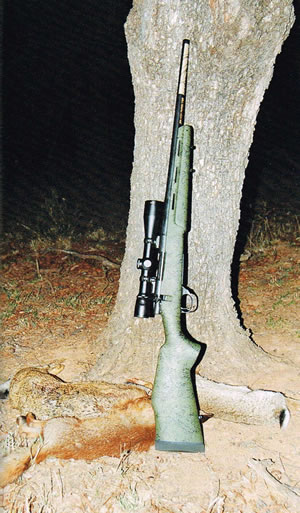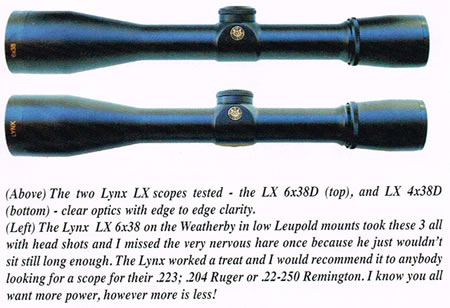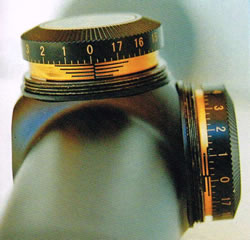

Lynx LX 4x38 D & LX 6x38 D - By Andy Montgomary


The old dinosaur has at last got something that ticks all but one of the boxes when it comes to great hunting scopes. What is the box that isn’t ticked? A couple of weekends back I had a visit from my cousin Robert who had bought a friend out with a Mauser 03 for me to have a look at and he bought a bit of nostalgia with him in the form of a Winchester Model 70 in 220 Swift. Robert’s dad had bought the rifle from Don Black in about 1962 or 3 for shooting Wedge Tailed Eagles as they were in plague proportions and actually had a bounty on their heads a bit later in the 1960’s. But can anyone guess what power scope the old Swift had in a set of Don Black mounts? A little 4x32 Prominar with plain cross hairs. Now in this day and age you would be laughed off a range if you turned up with a .220 Swift with 4x32 as the scope. Robert told the story about digging the old Winchester out after 30 odd years of being a safe Queen to dispatch a couple of ferals. and after 5 shots there were five dispatched ferals at ranges of up to 300 plus yards. It’s a pity Rob didn't realise that modern shooters would tell him that little scope wouldn’t work on a .220 Swift, bet the ferals wished it didn’t work too! So have you guessed which box isn't ticked yet?
Malcolm Gault from Lynx Optics gave me the 6x38 test scope at the August 2012 Penrith gun show and told me there would be a 4x38 coming. Now some 12 months or so ago I asked if he had any good quality 4 power scopes? The answer was “yes, a LX 4x38 D.” “Great. can I have 3 or 4?” “No, you can have the only one in existence!“ “Okay. that’s a start.” So I have been using one of the new scopes for a while, and it is a beauty! The unticked box for me is the true "dinosaur reticle” - a “Flat Top Post”. I know... why would you want one of those? Well I am not allowed that much space for an explanation, except to say it‘s an experience thing.
 |
|
| (Above) The Lynx test target. The 6x38 was mounted on the old green gun in 6x47, and the 4x38 was mounted on the 6mm PPC Remington 700. If you look at the whole test these two scopes performed pretty well. If you discounted the left hand bullet hole of the last 2 shots with the 4 power all the other 29 shots would have landed inside 0.5” had I not been adjusting the scopes. | |
So what do you get with these scopes? First and for most is good clear optics with edge to edge clarity that is as good as it gets with bright field of view and good contrast of the reticle against the image. The next most important consideration is stature or physical size, which dictates how low you can mount the scope. You might notice I nearly always quote OD (Outside Diameter) of the lens housings because that’s the important bit that gets in the road of bolt handles and barrels. The other important one is tube length because you need a small amount of lateral adjustment to get eye relief right, especially if there is stiff recoil involved. So the important dimensions for these two scopes are: Ocular lens housing (the back one) 38mm (1.5”), objective lens housing (the front one) 45.3mm (1.78”), usable tube length 138mm (5.375”), OAL 295mm (11.625") +/- focus length adjustment.
Actual eye relief is 85mm (3.375”) this measurement is taken from the back of the housing (not the lens), because it’s the housing that will bite you, not the lens during recoil. This measurement is achieved by placing the scope on a table and having a box sitting approximately 80mm from the ocular lens and shining a torch through the objective and moving the box closer and further from the scope until the image of the torch light comes sharp. You need to try it to see what I mean. Then measure the distance from the box to the back of the ocular housing and that is true eye relief.
The new turrets on these scopes are some of the best I have used from any manufacturer anywhere in the world. Now that is a statement! They have click adjustments that are absolutely accurate, see the round the target test. And that is two different scopes on two different rifles. They are zeroable (a new word for the dictionary) by pulling up on the adjustment wheel to disengage the drive to the adjustment spindle so the scale can be zeroed. The turrets are quite low (close to the scope body) and of reasonable diameter to ensure they are easy to adjust (the longer the lever the easier it is to move the load). There is a scale under the adjustment Wheel so you can see approximately how much of the adjustment has been used.
 (Left) The Lynx turrets on the 4x38 (the 6x38 are the same). The top or vertical adjuster wheel is in the pulled up position so it can be zeroed. Note the scale either side of the vertical indexing line to give you an indication of how much adjustment you have used. The new turrets on these scopes are some of the best I have used from any manufacturer anywhere in the world.
(Left) The Lynx turrets on the 4x38 (the 6x38 are the same). The top or vertical adjuster wheel is in the pulled up position so it can be zeroed. Note the scale either side of the vertical indexing line to give you an indication of how much adjustment you have used. The new turrets on these scopes are some of the best I have used from any manufacturer anywhere in the world.
How did they perform? Well I think the test target tells the main story, although I was a little disappointed with the group I achieved with the 4 power on the PPC particularly when I know it can shoot better than that. I think that these results give the general idea that these scopes are better than I am. These scopes are designed primarily for hunting so their target performance is just an assurance that they will do anything you ask of them when hunting. The biggest handicap these scopes have is that for too long the industry has been telling us all that more power means better and easier shooting. When in actual fact it means a bigger handicap for those of us that don’t do enough practise. Now I quite often get asked what scope is best for general hunting. “Hunting what?" Is my usual reply, and invariably it is pigs, goats, foxes, rabbits, the odd crow and a hare. From my experience most game is taken inside 150 metres. Before you all say, but I shoot a lot further than that, I want you all to step out the next 20 dispatches you get and do an average to see that I’m not close to the mark. Now I know there are blokes out there that deliberately set themselves out to try and take game at extreme ranges and nobody likes to pull off that long shot more than me. But I am talking about the vast majority of your hunting not that very odd shot. So these two scopes will cover the average hunting situation admirably. These little scopes are considerably cheaper than variable models so you can buy more ammunition.
In conclusion, these two little scopes will be staying here because their performance has been absolutely fantastic. I would have no hesitation in fitting them to any rifle I needed to perform first time every time. I put the 4x38 on the old 8mm and took it into the field and had 5 for 5, now it doesn’t get much better than that. I would have no doubt if I were to put the 6x38 on a .204 Ruger or .220 Swift it would have no trouble in guiding my shot home, providing I did my bit. Now I just need some with a Flat Top Picket! Dream on Monty! For further information visit www.lynxoprics.com.au
